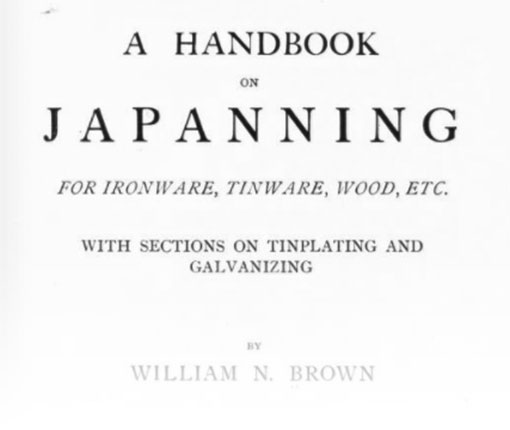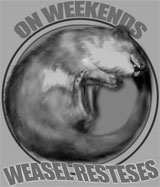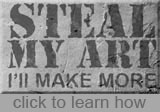You’re welcome!

Do we use the word “japanning” in the States? See, I’ve always been a Winsor & Newton kind of gal, and they’re a British company that sells japanned watercolor boxes, so I’m unsure of the origins. Well, anyhoo, it’s a durable, waterproof, shiny black coating on (usually) metal. Early car parts were sometimes japanned, for example.
It’s called ‘japanning’, by the way, because it was in imitation of Japanese black lacquerware. Proper lacquer is done with sap from the lacquer tree, duh. Here’s how Wikipedia describes it: “The sap of the lacquer tree, today bearing the technical description of “urushiol-based lacquer,” has traditionally been used in Japan. As the substance is poisonous to the touch until it dries, the creation of lacquerware has long been practiced only by skilled dedicated artisans.”
My new watercolor box is japanned (Brit style), and before it came, I had no idea how damaged it might be, so I set out to see if I could learn the secrets of re-japanning.
Viola! I give you A Handbook On Japanning, 1913 edition. It turns out, it’s just shellac and pigment baked in a 300° oven. No, I haven’t tried it yet. My box doesn’t need it. But I’m itching to japan something.
I’m a huge fan of shellac. Big, big fan. Shellac is not as common here, go figure, but I do have sources. It has a bad reputation among artists because it’s yellow, but I have samples that are upwards of 35 years old and, yes, they’re yellow…but no yellower than the day I first applied it. Same is certainly not true of linseed oil or damar varnish.
Anybody want to japan a thing and get back to me?
Posted: September 6th, 2017 under art, personal.
Comments: 18
Comments
Comment from AliceH
Time: September 6, 2017, 11:12 pm
I’ve seen japanning used/referred to dozens of times. It occurs to me, though, all of them may have been in British literature or mysteries, so not a useful data point.
Comment from Ric Fan
Time: September 7, 2017, 12:02 am
I’ve heard the word before but I thought it was slang. I’m surprise you’re allowed to use it today. I hate that Jap is considered racist when it is only a diminutive of Japanese. And I especially hate that you cant even use the word in a WW2 context. Except for WW2, I pretty much enjoy Japanese people, culture, and art.
Comment from Deborah HH
Time: September 7, 2017, 1:09 am
When I worked as a newspaper photographer, I rolled my own: film cassettes that is. Tri-X Pan 400 in 100 ft. rolls, which was packaged in nifty metal canisters about 1.5 in thick and 5 inches in diameter—like little fruitcake tins (oh the film smelled as good as fruitcake too). I always wanted to paint on the cans, but Husband and Son were in Scouts and they snagged the cans as soon as I had an empty one. But there was a woman at the paper who painted beautifully, so I gave every third can to her, and she painted on them with acrylic paints. I don’t know if those cans would have been good for japanning, but I bet a real fruitcake tin would be. I don’t think a 300° oven would warp the metal.
Comment from lizardbrain – now with extra class
Time: September 7, 2017, 10:41 am
Ooo. I’m very partial to shellac as a finish on my wood projects. I have a bunch of the flakes (2 colors) sitting in my refrigerator right now. And I’m geek enough to now want to try to japan something.
I knew there was a reason I come here every morning. Thanx.
Comment from Durnedyankee
Time: September 7, 2017, 10:52 am
I’ve got an 1870’s book presumably written for the frontier handy person on everything from lye soap making and preserving hams (packed in charcoal) to mixing your own laudanum ( just Nick round to the pharmacist for the poppy juice).
In the home handyman section it covers japaning. If I recall right part of the receipe involves putting scraps of leather into the oven with whatever other chemicals you mixed and covered your target Japanese article with.
Even has a section on “women’s complaints”. Regular encyclopedia Britanica in one big book.
Dr Chases’s receipes is the name.
I admit to being recently tempted to try japaning owing to memories of a black lacquer jewelry box my dad brought home from the Pacific for my mother after the war. I just haven’t gotten around to rifling through the boxes of books to find old doc Chase’s method. I think he had 2 or three, depending on ingredients the reader had to hand.
Comment from Deborah HH
Time: September 7, 2017, 11:44 am
One of our family heirlooms is a small cedar chest. In the late 1930s, it was blistered and burned in a fire, then subsequently sanded anew, and coated with what I presume is shellac. It’s fairly banged up now, and needs the be refreshed, but I don’t want to destroy the patina nor sand it, and I don’t know for certain that is IS shellacked. Is there a test for shellac? Does anyone have a suggestion for dissolving and re-floating the finish?
I have used denatured alcohol and fine steel wool to clean old furniture before, with wonderful results, but I am reluctant to tinker with the cedar chest.
Comment from Wolfus Aurelius
Time: September 7, 2017, 12:18 pm
Isn’t there a line in the lyrics of the song “Jackson” that uses “japanned”? (Original version, as far as I know, with Johnny and June Carter Cash, but then Nancy Sinatra and Lee Hazlewood did a version on one of her albums.) Something about “my japanned plan” or “japanned fan,” neither of which makes any sense at all.
Trivia: urushiol is the active principle in poison ivy, and what your skin reacts to. I’m not surprised it could be poisonous!
Comment from lizardbrain – now with extra class
Time: September 7, 2017, 2:36 pm
The test I use for shellac: if it’s dissolved by denatured alcohol, it’s shellac.
Japanned fans used to be a big thing. (The small, fluttery things women used to use in the late 19th century.) As I recall, Nancy Sinatra blew the line by singing “japanned flan.”
Comment from Deborah HH
Time: September 7, 2017, 3:12 pm
Oh lizardbrain—thank you so much for the information. I can clean and refresh the cedar chest without fear.
Comment from Ric Fan
Time: September 7, 2017, 4:43 pm
Anybody know what you call that artform/craft where there are different colors of wood that are put together like a jigsaw puzzle and make a design? You use to see them on tables on such. My description does not do them justice. I was in a Berlin museum and they had a display of them. They were very popular in the late 19th Century. It appears they also came in kits and you could make them yourself at home. Nice idea.
Comment from peacelovewoodstock
Time: September 7, 2017, 4:50 pm
Wikipedia: “Urushiol-induced contact dermatitis (also called Toxicodendron dermatitis and Rhus dermatitis) is the medical name given to allergic rashes produced by the oil urushiol, which is contained in various plants, most notably those of the Toxicodendron genus: the Chinese lacquer tree, poison ivy, poison oak, and poison sumac.”
Um, yeah, let it dry before you pick it up.
Comment from peacelovewoodstock
Time: September 7, 2017, 4:53 pm
Ric Fan, I think you are referring to “parquetry” or “marquetry” .. and you can still buy neat kits, e.g., see https://www.etsy.com/shop/EZMarquetry
I think “parquetry” generally refers to patterns on wood floors or larger furniture pieces, and “marquetry” to smaller, decorative designs.
Comment from lizardbrain – now with extra class
Time: September 7, 2017, 6:21 pm
Deborah HH:
I’m hoping you tested the chest in a small, inconspicuous spot, first, and that what you mean is that you can clean it using something other than denatured alcohol. Spreading denatured alcohol over an old shellac finish will partially dissolve that finish and end up leaving it rough and dull-looking, with much debris embedded. You can add a coat (or more) of new shellac over the existing finish once it’s cleaned with something other than alcohol. Good luck.
Comment from S. Weasel
Time: September 7, 2017, 9:15 pm
I knew urushiol sounded familiar!
Related to marquetry, see Tunbridge Ware, a local Brit thing where they bundled together long wooden rods to make pictures and then sliced them up into individual thangs. Can be very pretty, though the dyes have faded in most cases.
Comment from Ric Fan
Time: September 7, 2017, 9:58 pm
Thanks peacelovewoodstock & stoaty! Marquetry it is.
Comment from Daniel
Time: September 8, 2017, 11:25 pm
Lacquer is not the same as Shellac. Shellac is a resin exuded by the lac beetle, somewhere in India. Shellac is ground and mixed with ethanol with or without pigments. It was also a “plastic” material used before modern-day vinyl, etc.
Comment from Rich Rostrom
Time: September 11, 2017, 7:23 pm
In Oliver Twist, the Artful Dodger refers to having his boots polished as ‘japanning his trotter-cases’.
Which is interesting, because Oliver Twist was published in 1837-1839, long before Japan was opened to trade.
Comment from Durnedyankee
Time: September 11, 2017, 7:49 pm
@Rich – I hate to base my history reference on James Clavell, but it’s quick and dirty.
If “Shogun” is even mildly accurate the Portuguese had trade missions set up in Japan long before Commodore Perry dragged the Japanese into the 19th Century at cannon muzzle point so it would explain how the japanning technique was known to Chuck Dickens.
And lacquer is made from beatle squeezings?
Beatlejuice?
🙂
How cool is that?
Silk from worms, lacquer from beetles, poison ivy paint? It’s awesome that we alien humans are so good at exploiting Gaia’s creations.
I like imagining how it was all discovered.











Write a comment
Beware: more than one link in a comment is apt to earn you a trip to the spam filter, where you will remain -- cold, frightened and alone -- until I remember to clean the trap. But, hey, without Akismet, we'd be up to our asses in...well, ass porn, mostly.<< carry me back to ol' virginny